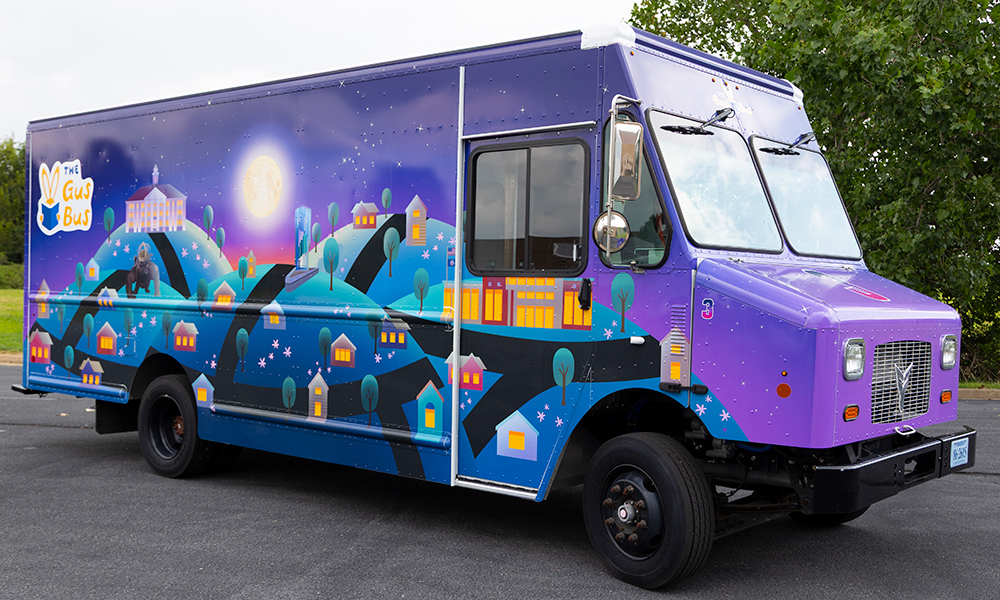Gus Bus Adds Custom Electric Vehicle to Its Fleet
New, Electric Gus Bus Allows the After-School Program to Expand Services
College of Health and Behavioral Studies
The Gus Bus, a literacy program in JMU’s Institute for Innovation in Health and Human Services (IIHHS), brings after-school learning directly to students by visiting several neighborhoods across Harrisonburg in their unique mobile classroom vehicles.
The Gus Bus has sustained their programs with two buses since 2005, but thanks to a partnership with Virginia Clean Cities (VCC), another vehicle is joining the fleet – a customized electric Gus Bus.
“We have been really limited in capacity with just our two vehicles,” said Rachel Gagliardi, Program Director for Gus Bus. “They are maxed out, with both of them going out every afternoon for several years.”
The new vehicle will allow the Gus Bus to expand their services, maintain their schedules in extreme weather and alleviate overhead costs for the grant-funded program.
“Because we are grant funded, not having to purchase gas will be big for us,” said Gagliardi. “The amount of gas we go through, not just driving around but also using our generators, is quite a lot.”
The new vehicle, procured by VCC, won’t be “burning a ton of gasoline or diesel to run the vehicle while children are inside it or around it,” preventing visitors from being “exposed to harmful emissions,” said Matt Wade, Deputy Director of VCC. He explained that EVs use about a dollar per gallon equivalency to gasoline prices, contributing to lower operational costs.
 Virginia Clean Cities is a US Department of Energy designated coalition, which formed a partnership with JMU in 2009 and has a local office housed in the Research, Economic Development and Innovation (REDI) department.
Virginia Clean Cities is a US Department of Energy designated coalition, which formed a partnership with JMU in 2009 and has a local office housed in the Research, Economic Development and Innovation (REDI) department.
“We’re tasked with deploying and demonstrating alternative fuel vehicles and clean transportation technologies in Virginia,” said Wade. VCC works to identify fleets, communities and private businesses that want to utilize alternative fuel vehicles in Virginia.
“One of the projects we’ve been working on over the last couple years is the Mid-Atlantic Electric Partnership,” said Wade. “This is a Department of Energy grant we received in 2020. In addition to deploying electric vehicles and charging stations, we wanted to deploy an electric bookmobile.”
“I’d spoken to the Gus Bus leadership, and they’d indicated the need for a new vehicle, and I thought—why not an electric one?” said Wade. VCC and the Gus Bus have been working toward acquiring a new electric vehicle since 2023.
The Gus Bus will have a charging station installed at their new office this summer, so that staff can park it after programs end in the evening and “it’ll be ready to go the next day, fully charged,” said Wade.
Along with lowering operational costs, the new vehicle’s customized interior and exterior will draw the attention of neighborhood children and provide a learning space optimized for students and teachers.
“Inside is all wooden, which will help with sustainability by holding up to wear and tear better,” said Gagliardi. “We were able to customize the shelving, the cabinets and the teacher’s desk in ways we recognized in our older buses that could be improved.”
“It’s really beautiful, too,” said Gagliardi, citing the unique and calming design of the wood interiors.
The new vehicle has two air conditioning units and improved insulation which will help address the problem of heat waves and freezing temperatures for the program.
“Hopefully that will help with extreme weather, allowing us to be out in neighborhoods more and having to cancel less,” said Gagliardi.
 Gagliardi said the program will slowly introduce the bus into the program’s existing schedule over the summer and into the fall, allowing Gus Bus staff to be acclimated to driving the new vehicle and troubleshoot any problems that may arise with regular use.
Gagliardi said the program will slowly introduce the bus into the program’s existing schedule over the summer and into the fall, allowing Gus Bus staff to be acclimated to driving the new vehicle and troubleshoot any problems that may arise with regular use.
“Hopefully, by next spring, we will explore funding opportunities to expand programming for neighborhood stops” into surrounding areas, including Rockingham, Page and Shenandoah counties, said Gagliardi.
The exterior of the new vehicle features designs created by Carrie Chambers (’24), a senior Graphic Design Intern for CHBS’s Creative Services team with support from Josh See, Visual Marketing Lead for Creative Services.
The other two vehicles in the Gus Bus fleet received new wraps that featured an updated logo and new, colorful design to increase visibility and recognition in neighborhoods in 2022.
The new, electric Gus Bus vehicle is wrapped in a similar design to the other vehicles and features a nighttime motif, utilizing deep purples and blues with bright stars and a full moon. The design highlights Harrisonburg landmarks including the City Hall building, the downtown Beacon art sculpture and the Court Square courthouse along windy roads and hills.
Gagliardi shared that Gus Bus staff are thrilled with the new vehicle and the new exterior design. “It’s very bright and exciting – which isn’t easy to do with a nighttime scene,” said Gagliardi.
“It looks great,” said Wade. “Everything is functional and working great. We’re very excited to be able to get it out into the community.”
